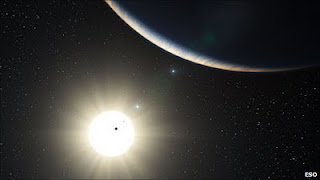The sun is entering into the peak of the 11 year cycle and the concepts of sunflares and sunspots have become the burning topic even among the illeterate people. The present theories are based on the principle that the sunspots are the result of heat flowing into the spot where magnetic fields are formed due to lower temperatures existing which are the result of reduction in pressure due to hydrogen atoms present at that spot. But the new theory put up by the researchers at Hawai explains this in a different way. They, Instead of looking at the hydrogen atoms in the sun, started looking up at the hydroxyl atoms which break up into hydrogen and oxygen at even lower temperatures than that of the hydrogen atoms. Thus they declared that those are hydroxyl atoms leading to the sunspots.
You know when it is a strange topic, that too related to astronomy, people drive themselves crazy with n number of theories. So only thing we as observers need to do is consider the principles and concept of every theory in order to build up a perfect theory. Anyways stay glued for more updates regarding the upcoming theories about the sunspots because you know this is the sunspot-season ;-)
Signing off for today yours Pranu :-)
Ref: Accuweather
Date: 02-02-2012


